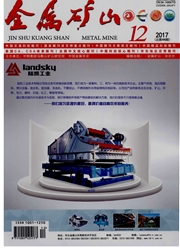

 中文摘要:
中文摘要:
有不同谷物尺寸的小粒的矿石媒介的二维的图象从 X 光检查被获得计算断层摄影术。与数字图象和有限元素技术处理结合了,原来的灰度图象直接被转变成有限元素模型。由使用这些模型,在粒子之中的毛孔规模液体流动的模拟与 COMSOL Multiphysics,和液体流动速度的分发特征被进行,压力被分析。模拟结果在那里显示出那存在在每小粒的媒介的明显的优先的流动和沥滤的盲目地区。在毛孔喉咙的流动速度比毛孔身体和最大的速度的到达 0.22 m/s 的大。速度从毛孔喉咙和身体的中心逐渐地减少到粒子的表面。当在大多数有更小的谷物尺寸的小粒的媒介的区域的液体流动速度更低时,有更大的谷物尺寸的小粒的媒介的流动路径同等地散布,并且他们中的一些走近到零,因此渗透是很低的。在那里存在某毛孔与不同压力聚类,它是为不平的流动速度分发的基本原因。
 英文摘要:
英文摘要:
Two-dimensional images of the granular ore media with different grain sizes were obtained from the X-ray computed tomography. Combined with the digital image processing and finite element techniques, the original grayscale images were transformed into the finite element models directly. By using these models, the simulations of pore scale fluid flow among particles were conducted with the COMSOL Multiphysics, and the distribution characteristics of fluid flow velocity and pressure were analyzed. The simulation results show that there exist obvious preferential flow and leaching blind zone in each granular medium. The flow velocity at pore throat is larger than that of pore body and the largest velocity reaches 0.22 m/s. The velocity decreases gradually from the center of pore throat and body to the surface of particles. The flow paths of granular media with larger grain size distribute equally, while the fluid flow velocities in most of areas of granular media with smaller grain size are lower, and some of them approach to zero, so the permeability is very low. There exist some pore clusters with different pressures, which is the basic reason for the uneven flow velocity distribution.
 同期刊论文项目
同期刊论文项目
 同项目期刊论文
同项目期刊论文
 3D characterization and analysis of pore structure of packed ore particle beds based on computed tom
3D characterization and analysis of pore structure of packed ore particle beds based on computed tom Investigation on the threshold control of safety blasting vibration velocity for the extraction of c
Investigation on the threshold control of safety blasting vibration velocity for the extraction of c The effect of solid components on the rheological and mechanical properties of cemented paste backfi
The effect of solid components on the rheological and mechanical properties of cemented paste backfi Leptospirillum forms a minor portion of the population in Zijinshan commercial non-aeration copper b
Leptospirillum forms a minor portion of the population in Zijinshan commercial non-aeration copper b Comparison of the electrochemical mechanism of chalcopyrite dissolution in the absence or presence o
Comparison of the electrochemical mechanism of chalcopyrite dissolution in the absence or presence o 期刊信息
期刊信息
